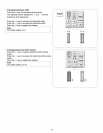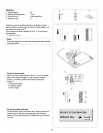
Blind Hem Stitch
Stitch pattern: 12
Needle thread tension 1 to 4
Presser foot G: Blind hem foot
Pressure dial 3
S
i
®
Use the same color thread as the fabric.
On heavy weight fabrics that ravel, the raw edge should be
overcast first.
Fotd the hem, as illustrated.
Wrong side (Bottom side) of fabric
1/4" to 7/16" (0.4 to 0.7 cm)
Light weight fabric
Heavy weight fabric
• To sew
When the needle comes to the left
When the needle comes to the right
Guide
Folded edge
There is a sliding guide screw on the blind hem foot that
allows you to precisely control where the needle pierces
the edge of the fabric fold. Adjust the screw so that at the
leftmost position of the stitch, the needle just pierces the
edge of the fold. If the needle pierces too far left, the
stitches will show on the right side of the fabric. Lower the
presser foot. Sew, guiding the folded edge along the guide
in the foot _.
ShellTuck
Stitch pattern: 14
Needle thread tension 6 to 8
Presser foot F: Satin stitch foot
Pressure dial 3
® ®
®
J
J
Use a lightweight fabric (tricot, for example). Fold the fabric
in bias and stitch on the fold. Allow the needle to just clear
the folded edge to create a shelled edge.You may need to
increase the needle thread tension slightly.
If you sew rows of shell stitches, space the rows at least
5/8" (1.5 cm) apart. You can also sew shell stitches on knits
or soft silky woven fabrics, in any direction.
................. J
J
35


















